Injury to the Intervertebral discs is a common cause of spinal pain. There is poor understanding of how / why discs are injured so often. There are many names used to describe these injuries which facilitates and perpetuates this poor understanding.
The disc can be injured in a number of ways. The pain associated with disc injury is rarely from the disc itself but more likely for surrounding tissues.
The disc is formed by laminated layers of cartilage, which form the wall or Annulus of the disc, which encloses a gel like liquid called the Nucleus. The nucleus attracts water very strongly and draws it into the disc when not weightbearing i.e. when we lie down - increasing the internal disc pressure. The wall of the disc is blended to the vertebra bone above + below, and completely enclosed on all sides by the strong spinal ligaments. Therefore the disc cannot “go in or out”.
The laminated structure of the disc allows a little bending. Move-ment is produced by combining of several little movements at a number of segments at the same time.
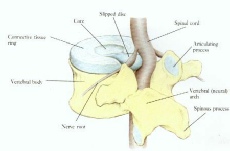
Over many years there is a gradual loss of fluid from the disc and it gradually solidifies between 50-60 years old. This is normal age related degeneration of the disc. Discs do not generally produce pain. Discs are slow to heal and regain strength.
With movement + poor postures over years the wall of the disc begins to crack + split. As the disc wall weakens it may begin to bulge. If the disc wall fully splits open the nucleus gel oozes to the outside. This is commonly called a ‘slipped disc’,
Once outside of the disc it absorbs water strongly + expands rapidly. This can put pressure on the surrounding tissues, which includes nerves and cause pain and other symptoms.
A ‘worn disc’ appears thinner on x-ray. The gel in centre of the disc is reduced and no longer maintains the normal separation between the vertebral + joints. They are likely to wear or degenerate / become arthritic more quickly than normal.
Back pain isn’t usually a serious medical condition – it’s likely that a muscle or ligament is sprained..
Back pain is often linked with referred pain into one or both legs (sciatica), Other symptoms may include numbness + tingling in the legs & feet and muscle weakness due to nerve root irritation.
If you notice actual weakness of the muscles or lose bladder or bowel control, then you should see your doctor urgently.
If your back pain persists over time the lack of normal movement can cause disuse weakness of the muscles and joint stiffness. It’s important that you keep moving.
If your back pain is persisting and reducing your overall activity you should seek the assistance of chartered physiotherapist.
A physiotherapist can provide a variety of treatments. Exercise is the most important way that you can:
• ease stiffness and pain
• build up muscle strength and stamina
• improve your flexibility and general fitness.
These benefits continue after the pain and symptoms subside so it is advisable to persist with the exercises over time.
Consult Ennis Physiotherapy Clinic if you need an assessment, treatment or advice about your back pain especially if it has not settled within a few days
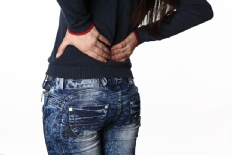
Postural strain is a common feature in spinal discomfort. ‘Normal’ posture develops during childhood - younger children generally have good postural habits. Poor postural can occur at any time but generally starts during teenage years. Seated posture is crucially important and even the best ergonomically designed furniture is not a guarantee of good posture. You can sit badly in any chair, even good chairs.
See the posture information page .Back to Top
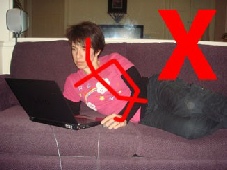
Most people suffer some neck pain during their life. Normal ‘age related’ wear and tear and poor posture is often observed. It is usually variable but not very severe. If you have
- Severe pain in the neck
- Pain in the shoulder and/or shoulder blade area or
- Pain down into the arm(s)
- Head pain or headache
then you need assessment and treatment by a chartered physiotherapist.
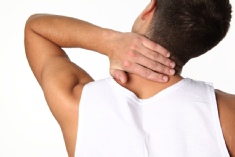
‘Whiplash’ injuries occur where a sudden movement of the head and neck sprain the soft tissues of the neck and shoulders. This can result in pain, stiffness and reduced movement / activity in the head, neck, shoulders and arms. Other symptoms can also occur. The duration of neck pain is very variable but 4-6 weeks, or more, is not unusual.
Headache can be caused by sprain / strains of the upper neck area. This type of headache has been shown to respond well to manual therapy and exercise treatment provided by Chartered Physiotherapists.
Remaining as active as possible and physiotherapy treatment can accelerate your recovery.
Contact the clinic if you would like have an assessment and/or treatment of your neck, head, shoulder or arm pain. Back to Top
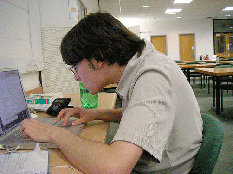
- Maintain good posture + alignment of the head and neck (ears over the shoulders).
- Avoid excessively slouched positions, relax the shoulders and stand or sit tall.
- Avoid Prolonged Sitting
- Sit with good spinal support
- Set up computer screens correctly
- Tilt / lift reading material up towards you in front
- Use a hands free set up if on the phone a lot
- Do not hold phone between ear and shoulder
- Do not slouch while driving
- Sleeping
- Don’t sleep on your stomach
- Sleep on the back or your side
- Support the neck only with pillows to maintain good alignment of the head and neck - 1 if on your back, 2 if on your side and it should not be under the shoulder
- Avoid prolonged static postures - keep moving
- Avoid excessive looking or reaching upwards
- Avoid carrying a bag on one shoulder. Spread the pressure evenly over both shoulders
Consult Ennis Physiotherapy Clinic if you need an assessment, treatment or advice about your neck pain

Exercise programmes need to develop flexibility and strength.
A good attitude to protecting your discs is required - it is not what you do so much as how you do it!
An injured disc can recover and can become strong again - it must become ‘fit’ for what it needs to be able to do each day. It must be protected and cared for.

The exercise above is an example of how the spine can be exercised into flexed postures which are relatively safe for the disc. The best exercise programmes will include a variety of physical activities which include some stretching , some strengthening and some functional exercises. Core stability, Pilates and Yoga may fall into this category. Back to Top
Treatment minimises the impact of the injured tissues and of further injuring the disc itself.
Management of pain and the loss of normal movement in the spine are the key goals. A combination of treatments are used to achieve this.
- Rest and avoiding things that aggravate the pain is needed initially but as quickly as possible get back moving.
- Avoid sitting down if possible.
- Maintain good postures whether sitting or standing. .
- Begin home exercises as soon as possible
- Remain as active as possible - doing things will make your back strong again
- Be proactive in preventing and protecting your discs from further injury.
- Consider ergonomic advice when selecting furniture, cars, work postures, planning work and leisure activities.
- Strengthen your spine when the disc injury is resolved and regain max ‘control’ over core stability and movement.
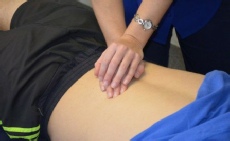
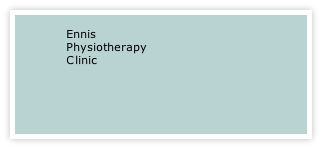




Mon - Fri 9.30am - 8.30pm


3A Barrack Close, Barrack St., Ennis, Co. Clare V95 X437

065 6840757
| Health+Safety Services |
| Sports Clubs+Teams Services |
| Standing Posture |
| Sitting Posture |
| Childhood Posture |
| Using Portable Devices |
| Normal Walking |
| Running |
| Running Drills Videos |
| Muscle Energetics |
| General Fitness |
| Losing Body Weight |
| Gaining Body Weight |
| Weight Loss Programmes |
| Start to Run |
| Start to Swim |
| Start Cycling |
| Start Nordic Waliking |
| Rehab of Tensdons |
| Loading of Tendons |
| Non Specific LBP |
| Posture |
| Intervertebral Disc |
| LBP Treatment |
| Non Specific Neck Pain |
| Neck Care Advice |
| Hamstring Strain |
| Ankle Sprain |
| ACL Injury |
| Joint Replacement |
| Shoulder Dislocation |
| Tennis Elbow |
| Wrist fracture |
| Fractured Knuckle |
| Selecting a Racquet |
| Racquet Grip Size |
| Racuet Sport Injuries |
| Training for Racquet Sports |
| Ski + Board Injuries |
| Injury Videos |
| Injury Prevention |
| Preventing Injury in Musicians |
| Irish Dancing |
| Preventing Dance Injury |